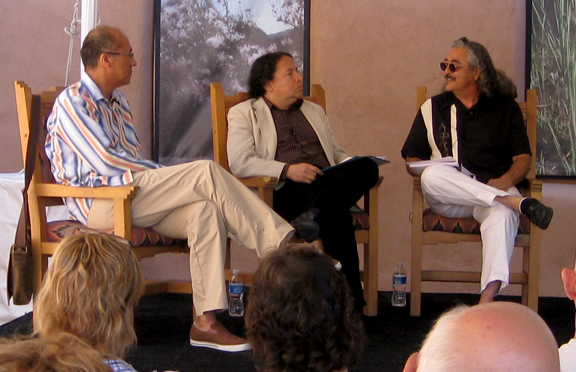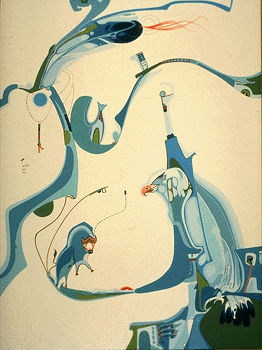Joseph Marcus Sánchez, artist, curator (born 24 February 1948 in Trinidad, Colorado, United States). In 1970, Joseph Sánchez travelled to Canada, settling in Richer, Manitoba. He became a founding member of Professional Native Indian Artists Inc., known widely as the Indian Group of Seven. Sánchez remained in Canada until 1975-76, leaving a lasting impact on the recognition and exposure of First Nations art and artists. Sánchez went on to become a community elder and political activist. He has worked as a museum director and curator for major galleries and exhibitions. His artwork has been exhibited extensively in Canada, the United States and Europe, and he has provided essays for a number of exhibition catalogues.

Early Life and Education
Joseph Marcus Sánchez grew up in Whiteriver, Arizona, on the White Mountain Apache Reservation. (See also Reserves in Canada.) He has Pueblo, Spanish and German ethnicity.
Sánchez was a predominantly self-taught artist. He attributes the artists he has collaborated with and his work as a curator with his skills and education in fine art. Sánchez showed a proclivity for art and painting in elementary school. His fifth grade teacher, Ms. Gutierrez, noticed his talent and encouraged him in painting, first on glass, and also his embroidery work. Sánchez went on to paint large portraits of his family and friends throughout high school. He became interested in the artistic movements and art of the Renaissance, Dadaism, surrealism and contemporary art. (See also Contemporary Indigenous Art in Canada.)
When Sánchez graduated from Alchesay High School in Whiteriver in 1966 he had not yet decided on a career as a painter and instead intended to join the priesthood. Sánchez began working in what would become his signature surrealist style while in the United States Marine Corps in 1968. He drew the first draft of his work Unconsummated Rape of Mongo on newsprint. He told Alberta Native News that this was “a first look into my psyche.” While in the United States Marine Corps, Sánchez trained soldiers drafted for the Vietnam War, but left soon after and became considered AWOL.
Career Highlights
Joseph Sánchez travelled to Canada in 1970. He met photographer Ann Nadine Krajeck, whom he married and lived with on a 20-acre farm in Giroux, Manitoba. Two years later, in 1972, Sánchez became one of the founders of Professional Native Indian Artists Inc., known widely as the Indian Group of Seven. The other members were artists Daphne Odjig, Alex Janvier, Norval Morrisseau, Jackson Beardy, Eddy Cobiness and Carl Ray. The collective officially incorporated in 1975. Although many artists were invited to participate, it was ultimately these seven artists who came to Winnipeg, Manitoba, Canada, to form the group.
Sánchez was commissioned to create the painting The Virgin of Light in 1974, which would be presented as the Juno Award for Multiculturalism in Music that year. The Toronto Wax Museum created a wax figure in the likeness of Sánchez with The Virgin of Light painting in the same year. Sánchez was also commissioned to create Fertility Totem in 1974, a 2.75 m sculpture installed in the Centre culturel franco-manitobain in St. Boniface, Manitoba. It was created for display during the Winnipeg Centennial.
Sánchez was able to return to the United States under President Gerald Ford's historic amnesty program. His wife joined him in Arizona in 1978, and in 1981, they had a daughter, Rosa Nadine Xochimilco in Scottsdale. Sánchez later remarried (Margaret Burke) and had a son, Jerome Bonafacio Xocotl.
In 2006, Sánchez was awarded the prestigious Allan Houser Memorial Award for artistic excellence and community involvement, recognizing him as a leading activist for Indigenous arts. Bill Richardson, governor of New Mexico, presented the award to Sánchez at the New Mexico Governor’s Awards for the Arts.
Sánchez has held many prominent positions as curator and was appointed chief curator at what is now the IAIA Museum of Contemporary Native Arts in Sante Fe, New Mexico. He remained acting director of the museum until 2010, when he retired.
Promotion of Indigenous Arts
Joseph Sánchez is recognized as a leader in the promotion of Indigenous artists and their communities. He helped found the Movimiento Artistico del Rio Salado and Azoma art collectives. He was also involved in the formation of the Ariztlan art collective. Sánchez’s work in these collectives helped important Chicano artists to collaborate and exhibit work as a group. He also helped in founding the National Association of Artists’ Organizations, which aimed to benefit American artists nationally.
Publications
Joseph Sánchez's artwork is featured in the book 7: Professional Native Indian Artists: Group of Seven. In 2008, Sánchez had an essay published as the United States curator for the SITE Santa Fe Biennial.
In 2011, Dartmouth College included an essay written by Sánchez in their book on Native American art. At that time Sánchez was a curator for Native American Art at Dartmouth: Highlights from the Hood Museum of Art.
Significance
Joseph Sánchez’s art and activism has helped create spaces for Chicano and Indigenous artists, and especially for youth. His work in schools, as a curator, and in the collectives he helped founded has been inspirational and groundbreaking. He remains active as an artist in his community.
Honours and Awards
Alan Houser Memorial Award, New Mexico’s Governor's Award for Excellence in the Arts (2006).

 Share on Facebook
Share on Facebook Share on X
Share on X Share by Email
Share by Email Share on Google Classroom
Share on Google Classroom









